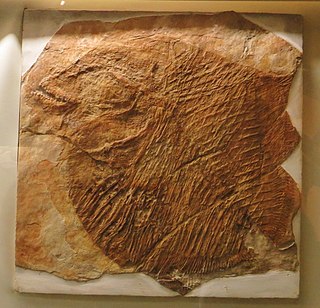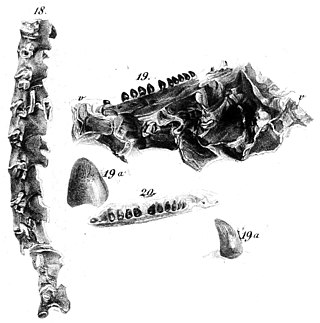
Aigialosauridae is a family of Late Cretaceous semiaquatic pythonomorph lizards closely related to the mosasaurs. Regarded by some paleontologists as a distinct monophyletic group and by others as an adaptive grade within the basal mosasauroids, recent molecular and morphological data suggests that they are the oldest known members of the lineage leading to the mosasaurs.
Judeasaurus is an extinct genus of small, aquatic varanoid lizard related to the mosasauroids. The only known specimen is from the Late Cretaceous of the Judean Hills around Israel and the West Bank, though its exact provenance is uncertain.

Adriosaurus is an extinct genus of squamate which lived in what is now Slovenia and other parts of Europe during the Late Cretaceous. It was a small, snake-like reptile, with the type species Adriosaurus suessi measuring up to 30 cm (12 in) in length. Adriosaurus represents the first occurance of vestigial limbs in fossil lizards, having lost its manus and forearm completely in order to elongate its axial skeleton. These unique anatomical features led to discussions of the evolutionary patterns of limb reduction in Squamata.

Mosasauroidea is a superfamily of extinct marine lizards that existed during the Late Cretaceous. Basal members of this group consist of small semiaquatic forms with terrestrial limbs ("plesiopedal"), while laters members include larger fully aquatic paddle-limbed ("hydropedal") forms commonly known as mosasaurs. These were traditionally grouped within their own separate families, the Aigialosauridae and Mosasauridae respectively. However, phylogenetic studies have since found plesiopedal mosasauroids to be a non-monophyletic group, with some taxa nestled within the mosasaurids.

Chirocentrites is an extinct genus of marine ray-finned fish in the order Ichthyodectiformes. It contains a single species, C. coroninii, from the Late Cretaceous (Cenomanian) of Slovenia. A potential specimen is also known from the Albian-aged Pietraroja Plattenkalk of southern Italy, but it has been suggested that this specimen actually represents Cladocyclus.

Tethysaurus is an extinct genus of tethysaurine mosasauroid from the Early Turonian period. The only species is Tethysaurus nopcsai.

Carsosaurus is a genus of extinct amphibious reptiles, in the mosasaur superfamily, containing only the species Carsosaurus marchesetti. It is known from a single individual that lived during the Upper Cretaceous in what is now Slovenia. The specimen is well-preserved, containing many different bones as well as some skin impressions and sternal cartilage. While more remains are needed to be certain, it is generally thought to belong to the Aigialosauridae. In life, it was an amphibious creature that spent most of its time on land, although its later relatives would become fully aquatic.
Eidolosaurus was a genus of mosasauroid from the Late Cretaceous period of Slovenia.
Vallecillosaurus is an extinct genus of mosasauroid from the Late Cretaceous period, that lived in Mexico, in the state of Nuevo León. It was a relatively small reptile measuring less than 1 m (3.3 ft) long.
Carsothrissops is an extinct genus of prehistoric marine ray-finned fish that lived during the Cenomanian. It contains a single species, C. delorenzi from Komen, Slovenia.

Coelodus is an extinct genus of marine and possibly freshwater pycnodont fish. It contains only one definitive species, C. saturnusHeckel, 1854, from the Late Cretaceous of Slovenia. Other species from the Late Jurassic to the Eocene have also been attributed to this genus based on isolated dental elements, but their assignment to Coelodus is uncertain, and this genus likely represents a non-monophyletic wastebasket taxon. A potential diagnostic trait is a prearticular tooth row with three regular highly elongated teeth.

Aigialosaurus is an extinct genus of Late Cretaceous marine or semiaquatic lizard classified as part of the family Aigialosauridae within the Mosasauroidea. Exclusively found in deposits of Cenomanian age near Hvar, Croatia, the genus contains one valid species, A. dalmaticus. According to recent molecular and morphological data, Aigialosaurus is the oldest known member of the lineage leading to large Cretaceous marine reptiles called mosasaurs, a group most closely related to snakes among living squamates. It was a relatively small reptile with a complete specimen measuring 65 cm (2.13 ft) long.

Opetiosaurus is an extinct genus of Late Cretaceous marine or semiaquatic lizard classified as part of the family Aigialosauridae within the Mosasauroidea. Exclusively found in deposits of Cenomanian age near Hvar, Croatia, the genus contain one valid species, O. bucchichi. It was a small reptile measuring 1 metre (3.3 ft) long.
Haasiasaurus is an extinct genus of early mosasaur, originally named "Haasia" by M. J. Polcyn et al., in honour of the palaeontologist Georg Haas. Haasiasaurus was one of the oldest cenomanian mosasaur measuring 1 metre (3.3 ft) long. The genus contains the species Haasiasaurus gittelmani, which was found in the Cenomanian 100 million years ago rocks near Ein Yabrud, in the Palestinian West Bank, approximately 20 kilometres (12 mi) north of Jerusalem.
Acteosaurus is an extinct genus of aquatic lizard that lived in the upper Cretaceous period. Its species, A. tommasinii and A. crassicostatus, were described in 1860 and 1993. Though A. crassicostatus is probably a junior synonym for Adriosaurus suessi, A. tommasinii was found to be similar to coniasaurs, mosasauroids, and a sister taxon to modern snakes in 2010.

Pannoniasaurus is an extinct genus of tethysaurine mosasauroid known from the Late Cretaceous Csehbánya Formation and Ajka Coal Formation of Hungary. It contains a single species, Pannoniasaurus inexpectatus, dubbed "unexpected" because it was discovered in freshwater sediments, unlike other mosasaurs, which were marine predators. It was a medium-sized mosasaur, reaching up to 6 metres (20 ft) in length.

Coniasaurus is an extinct genus of Late Cretaceous marine squamates that range in age from Cenomanian to Santonian. It was first described by Richard Owen in 1850 from lower Cenomanian chalk deposits in South East England (Sussex). Two species have been described from this genus: C. crassidens, known from Cenomanian to Santonian deposits from South East England, Germany and North America, and C. gracilodens from the Cenomanian of southeast England.

Dolichosauridae is a family of Cretaceous aquatic lizards. They are widely considered to be the earliest and most primitive members of Mosasauria, though some researchers have recovered them as more closely related to snakes.
Portunatasaurus is a genus of mosasauroid squamate that lived during the Late Cretaceous period in what is now Croatia. It contains a single species, P. krambergeri, recovered from the Adriatic-Dinaric Carbonate Platform. It was a relatively small reptile, reaching 1 m (3.3 ft) in length.











